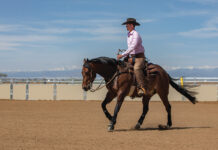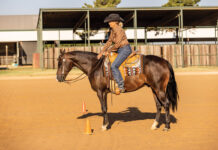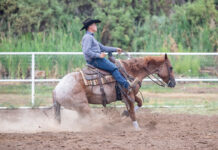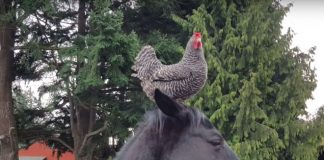A common misconception about riding horses is that reins slow them down and the rider’s legs make them go. That would be true, if your horse responded like a car.
When you have a lengthy multi-jointed spine, pulling on the reins compresses your vertebrae. The constriction that starts in your neck continues to travel down the back. Horses finding themselves in this situation try to relieve the pressure by inverting their topline, but that’s not a real solution and it causes further discomfort.
Forget trying to get a horse to do a pretty change of speed with a tense and aching back! She’ll have no choice but to alter her initial gait as she tries to accommodate her hollow frame. If she can stay in gait at all, it’s likely to be inconsistent, rough, and mechanical. If that weren’t enough, a steady pull can also cause a horse to desensitize and ignore the bit entirely or brace against the pressure.
Your horse’s hindquarters are the key to having her slow down seamlessly. Since your legs tell your horse to keep her rear in gear, lackluster leg contact and/or use is a near guarantee of total hindquarter shutdown. If that happens, you can say goodbye to the quality of your horse’s gait, or she may break gait, or quit moving altogether.
Another possibility that may actually seem counter-intuitive is that your goes faster when you ask her to slow. That’s because lack of support from the hind end means her weight shifts onto her forehand, causing her to scramble to maintain her balance.
While it takes hands and legs to reduce your horse’s speed, the initial cue comes from your body.
- Sit tall to decrease the weight on your horse’s back and invite her to elevate her spine. (Her back lifts to accommodate a deeper step from her hind legs when her hindquarters are engaged.)
- Next, gently tighten your core muscles. Your horse will respond to this cue by gathering herself under you – just make sure that when you contract your core muscles your pelvis remains relaxed and fluid.
- Then position your legs a couple of inches behind the cinch. This will stabilize your upper body and allow the greatest amount of contact between your calves and horse’s sides.
Riding two-handed in a snaffle, complete the go-slow request with a light squeeze of your calves and a soft feel of the bit. With open fingers on the reins, apply even and steady contact to your horse’s mouth. Let your elbows follow the natural motion of your horse’s head to help her stay relaxed, responsive, and give her hind plenty of room to step forward.
Matching the rhythm of her stride, softly press your fingers on your inside rein to promote a soft jaw and supple frame. If you feel your horse lose energy, smoothness, or rhythm, increase her forward energy by squeezing with your calves. Maintain passive leg contact when your horse doesn’t need any encouragement so you can provide support and be ready to help if she needs encouragement.






